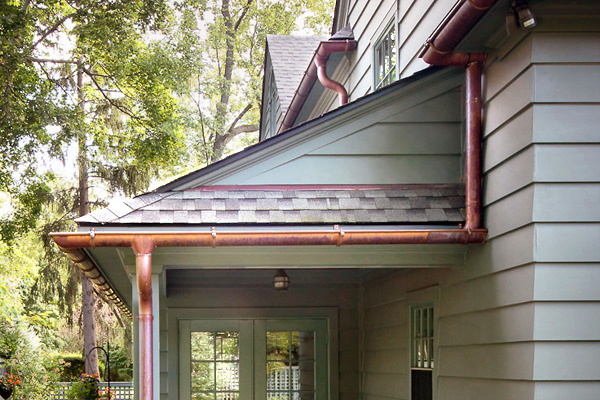
Types of Gutters and Costs
The good news: Gutters come in all shapes, colors, and prices so you can easily find a match for your style of house and budget.
Unfortunately, figuring the right sizes of the gutters and downspouts for your roof involves some head-banging mathematical formulas.
Not to worry. We’re here to guide you on the path to gutter glory. If you’d like to do your own calculations for sizing your gutters, we’ll help you through it.
Basic Types of Gutters
Let’s start with shapes. There are two basic types, and they’re referred to by the shape of their cross section. Both types come in 5- and 6-inch widths.
1. K-style gutters have flat bottoms and backs, and the front side of the gutter usually has a decorative shape, such as a curve or ogee, that mimics crown molding. Many styles are available.
2. Half-round gutters are exactly what the name suggests: half-round tubes. Half-round gutters often are found on older, historic homes.In general, K-style gutters have twice the capacity of their half-round cousins of the same width, and cost up to 50% more per linear foot.
Gutter Materials
Residential gutters are made from various metals, including:
Aluminum
- Most widely used material
- Lightweight and easy to install for DIYers
- Won’t rust
- .032- or .027-gauge thickness recommended for long-lasting duty in regions with snow
- Comes in various colors and can be painted
Copper
- Exceptional beauty
- Won’t rust
- No need to paint; will develop a patina over time
- Needs pro installation; seams and joints must be welded
- Used primarily on high-end residences and historic restorations
- Pricey
Seamless Aluminum
Seamless (or continuous) gutters are made at the job site. A truck with a spool of flat aluminum pulls up to your home, and the fabricator uses a gutter-forming machine to custom make whatever gutter length is required. There’s no hauling of long gutters. About 70% of all gutter installations are the seamless type.
Installing seamless gutters:
- Eliminates many seams and reduces chances of leaks
- Costs slightly more than regular aluminum gutters
Steel
- Strong
- Galvanized steel resists rust but longevity is an issue; may start to rust after 5 to 10 years
- Many color options; can be painted
- Heavy and not recommended for DIY
- Can be pricey
Vinyl
- Lightweight and inexpensive; good for DIYers
- Not many colors to choose from
- Color susceptible to fading from UV sunlight
- May crack in severe cold
- Won’t support ladders placed against them
Zinc
- Durable and long-lasting
- No need to paint; will develop a patina over time
- Needs pro installation; seams and joints must be welded
- Used primarily on high-end residences and historic restorations
- Expensive
How Much Gutter Do You Need?
Figuring gutters sizes and capacities is a complex brain-freeze equation involving the size and slope of your roof and the average maximum rainfall your area can expect. We recommend leaving the calculations to your gutter installation professional.
For the most part, you won’t go wrong with a 5-inch, K-style gutter. “A 5-inch gutter is pretty standard and will handle rainfall just about anywhere in the country,” says Bill Sheetz, owner of Lake Cook Exteriors in Palatine, Ill. He uses them on “almost all our installations.” And he specs oversized (3-inch-by-4-inch) downspouts to ensure good drainage.
Sheetz says a 6-inch gutter has almost twice the capacity of a 5-inch, but cautions that in cold climates, larger gutters run the risk of getting weighted down with ice that could damage the gutter system. Moving to a 6-inch gutter increases costs by about 25%.
Originally Posted here: How to Choose the Right Gutters for Your Home
No comments:
Post a Comment